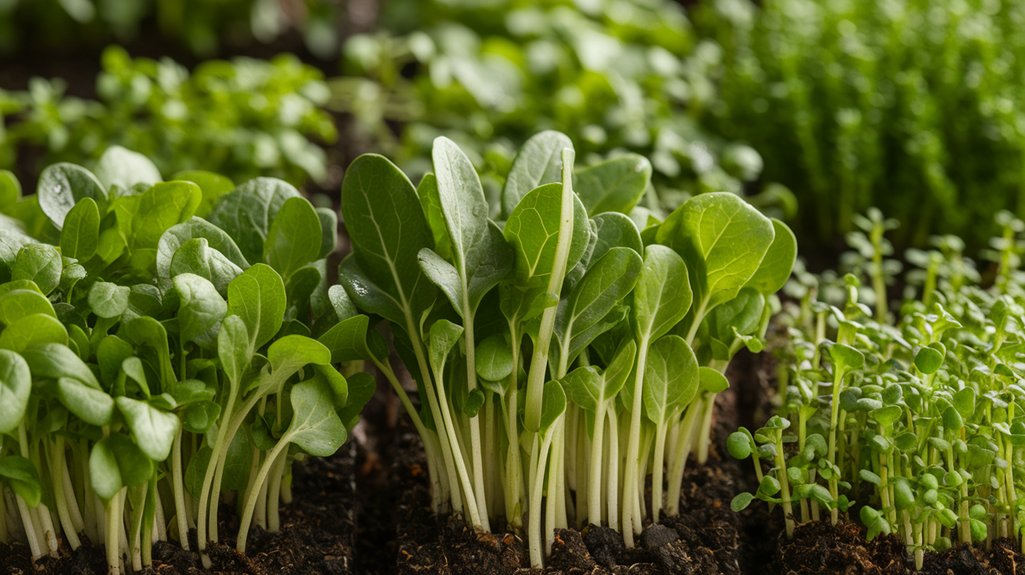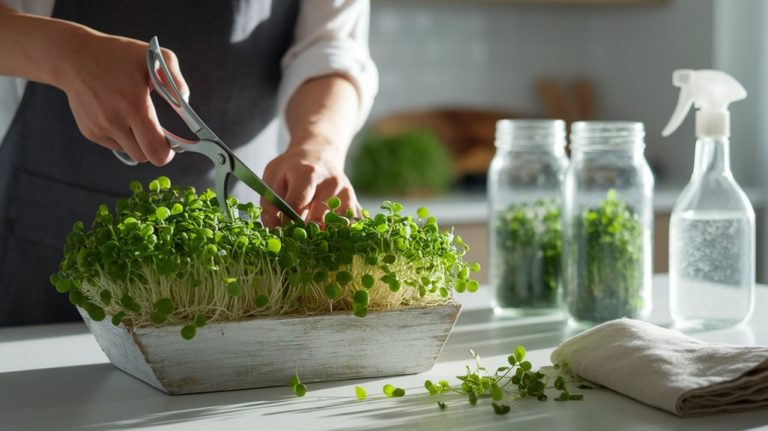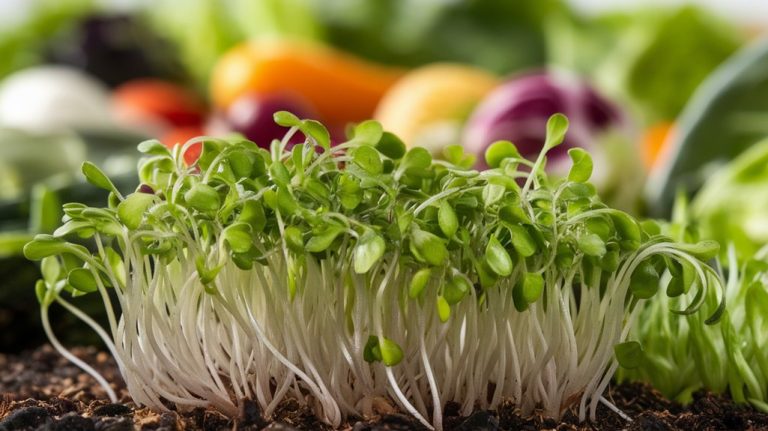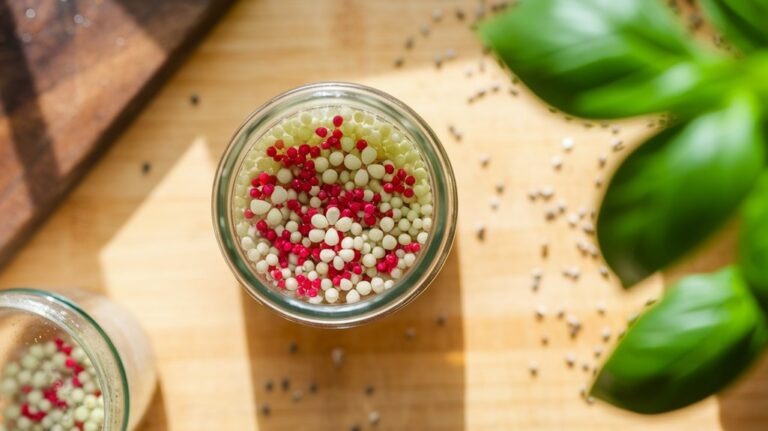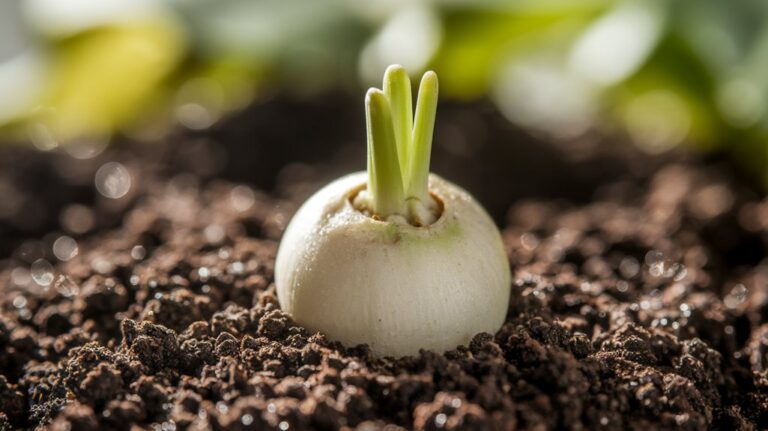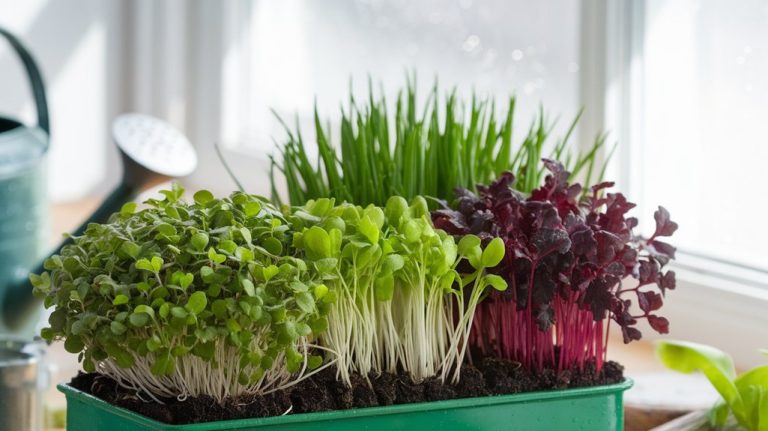Quick Harvests: 8 Fastest‑Growing Microgreens to Try
If you’re looking for quick harvests, I recommend trying microgreens like radish, broccoli, pea shoots, sunflower, mustard greens, basil, arugula, and beet. These vibrant greens grow in just 7 to 14 days, packing a nutritional punch. They’re perfect for adding flavor and health benefits to your meals. Plus, they’re easy to grow in small spaces. Keep exploring, and you’ll discover exciting ways to incorporate these colorful microgreens into your cooking.
Key Takeaways
- Microgreens typically mature within 7 to 14 days, allowing for rapid harvests and quick meal enhancements.
- Popular fast-growing varieties include radish, broccoli, pea shoots, sunflower, mustard greens, basil, arugula, and beet microgreens.
- These microgreens are nutrient-dense, providing vitamins A, C, K, and antioxidants beneficial for health.
- They can be easily grown indoors or outdoors, requiring minimal space and effort for cultivation.
- Culinary uses include adding flavor and color to salads, sandwiches, smoothies, and other dishes.
Radish Microgreens
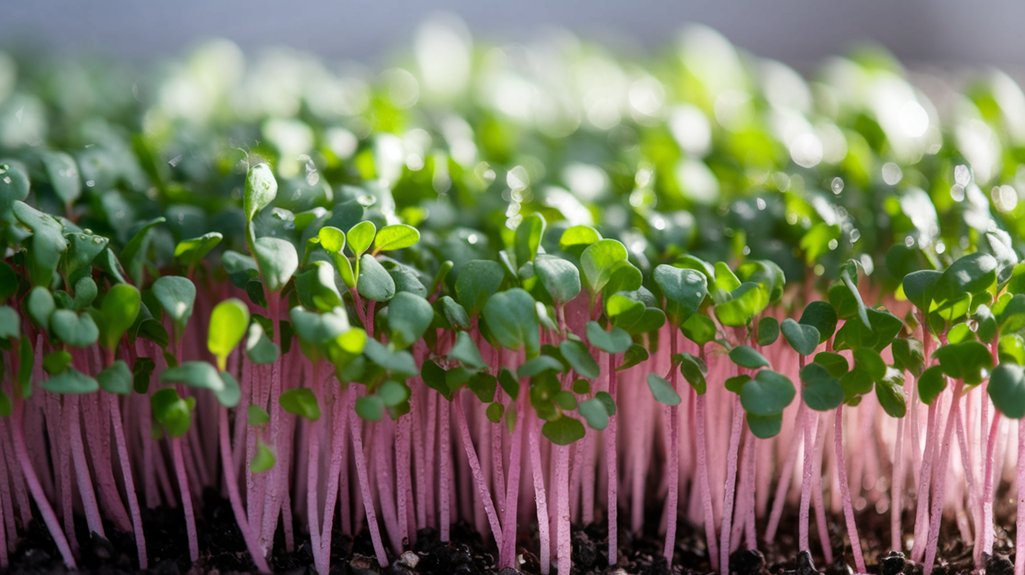
When I first started exploring the world of microgreens, radish microgreens immediately caught my attention for their vibrant color and peppery flavor.
These tiny greens aren’t just visually appealing; they’re also incredibly easy to grow. In just 7 to 14 days, you can harvest them, making them one of the fastest-growing options out there.
I love how they pack a punch of flavor, adding zest to salads, sandwiches, and smoothies. Plus, they’re rich in vitamins A, C, and E, along with antioxidants that promote overall health.
If you’re looking to start your microgreen journey, radish microgreens are a fantastic choice. Their quick growth and bold taste will definitely inspire your culinary creativity!
Broccoli Microgreens
Although they may be small, broccoli microgreens pack a nutritional punch that’s hard to ignore. I love incorporating these tiny greens into my meals because they’re rich in vitamins A, C, and K, along with powerful antioxidants.
They’re known to contain sulforaphane, a compound that supports detoxification and may have cancer-fighting properties.
Growing broccoli microgreens is a breeze, taking only about 7 to 14 days from seed to harvest. I find them particularly versatile; they add a delightful crunch and a slightly peppery flavor to salads, sandwiches, and smoothies.
Plus, they’re an excellent way to boost the nutritional value of any dish. Once you try them, you’ll see why they’re a favorite among health enthusiasts!
Pea Shoots
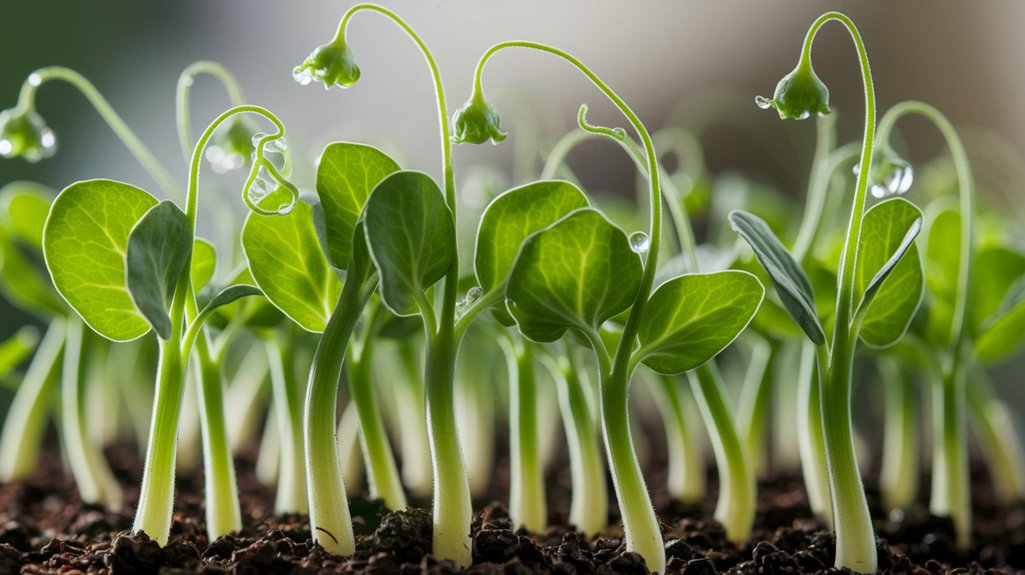
Pea shoots aren’t only quick to grow but also packed with nutrients, making them a fantastic addition to any microgreens garden.
I’ve found that their sweet flavor and tender texture can elevate a variety of dishes, from salads to stir-fries.
Let’s explore some tips on how to grow them effectively and the impressive health benefits they offer!
Nutritional Benefits of Pea Shoots
Microgreens, particularly pea shoots, pack a powerful nutritional punch that can elevate any meal.
These vibrant greens are rich in vitamins A, C, and K, which support immune function and promote healthy skin. I love how they’re also high in antioxidants, helping to combat oxidative stress in the body.
What’s more, pea shoots provide a good source of protein and fiber, making them a fantastic addition to salads, sandwiches, or smoothies. They’re low in calories but bursting with flavor, adding a delightful crunch to dishes.
Research shows that incorporating pea shoots into your diet can enhance overall health. So, if you’re looking to boost your nutrient intake, consider adding these delicious microgreens to your meals!
Growing Tips and Techniques
After exploring the nutritional benefits of pea shoots, I’m excited to share some effective growing tips and techniques that can help you cultivate these vibrant greens at home.
First, use a shallow container with drainage holes and fill it with a quality potting mix. Soak your pea seeds for a few hours before planting to boost germination. Scatter the seeds evenly and cover them with a thin layer of soil.
Water gently to avoid displacing the seeds. Place the container in a bright spot, ideally with indirect sunlight. Keep the soil moist, not soggy, and in about 7-14 days, you’ll see shoots ready for harvest.
Enjoy the process and the delightful crunch of fresh pea shoots in your dishes!
Sunflower Microgreens
Sunflower microgreens aren’t just visually appealing; they pack a powerful nutritional punch that can elevate any meal.
I’ll share some effective growing tips and techniques to help you cultivate these vibrant greens in your kitchen, along with a few tasty recipes to inspire your culinary creativity.
Let’s explore why sunflower microgreens deserve a spot on your plate!
Nutritional Benefits Overview
While exploring the world of microgreens, I’ve discovered that sunflower microgreens pack a powerful nutritional punch.
These tiny greens are rich in vitamins A, B, C, and E, making them excellent for boosting your immune system and skin health. They’re also a fantastic source of minerals like calcium, magnesium, and iron, which are essential for bone health and energy production.
What’s more, sunflower microgreens are packed with antioxidants that help combat oxidative stress in the body. Their high protein content supports muscle growth and repair, making them a great addition to a balanced diet.
Plus, with their nutty flavor, they can easily elevate salads, sandwiches, or smoothies while delivering impressive health benefits.
Growing Tips and Techniques
When I first started growing sunflower microgreens, I quickly realized that a few key techniques can make all the difference.
First, soaking the seeds for about 8 hours before planting helps jumpstart germination. I use a shallow tray with a quality potting mix, ensuring it’s moist but not waterlogged. After spreading the seeds evenly, I cover them with a thin layer of soil and gently mist them.
To maintain humidity, I cover the tray with a lid or plastic wrap until they sprout. Once they reach about 2 inches tall, I remove the cover and place them under bright light.
Watering from the bottom keeps the leaves dry and prevents mold. These simple steps lead to lush, delicious sunflower microgreens!
Culinary Uses and Recipes
After successfully growing sunflower microgreens, I’ve discovered just how versatile they can be in the kitchen. Their nutty flavor and crunchy texture elevate a variety of dishes.
Here are a few culinary uses I love:
- Salads: Toss them into fresh salads for a delightful crunch.
- Sandwiches: Add sunflower microgreens to sandwiches or wraps for an extra layer of taste.
- Garnishes: Use them as a vibrant garnish atop soups or grain bowls.
Not only do they enhance flavor, but they also pack a nutritional punch, being rich in vitamins and minerals.
Incorporating sunflower microgreens into your meals is an easy way to boost both taste and health, making them a staple in my cooking routine.
Mustard Greens
Mustard greens are one of the fastest-growing microgreens, sprouting in as little as 7 to 14 days.
I love their peppery flavor, which adds a unique kick to salads, sandwiches, and wraps. They’re not only delicious but also packed with nutrients like vitamins A, C, and K, along with antioxidants.
When I grow them, I usually start with seeds that are easy to find online or at local gardening stores. Just a little soil, water, and sunlight are all they need.
Harvesting is simple—just snip them above the soil line when they reach about 2 inches tall.
These microgreens can really elevate your dishes while offering health benefits, making them a fantastic addition to any home garden!
Basil Microgreens
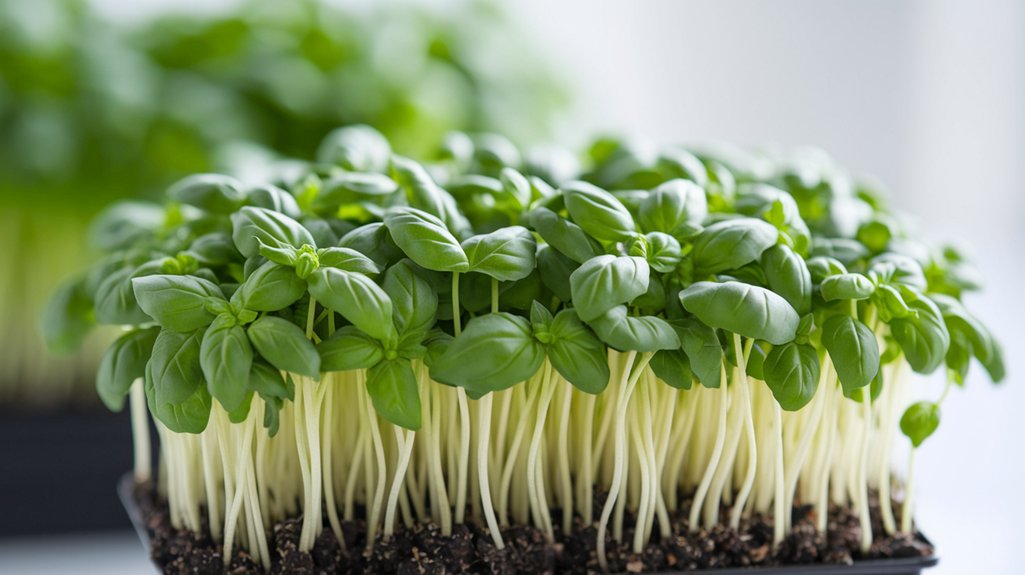
Basil microgreens are a delightful addition to any home garden, sprouting within 7 to 14 days.
I love how easy they’re to grow and the burst of flavor they add to dishes. Plus, they’re packed with nutrients!
Here are a few reasons why you should give basil microgreens a try:
- Flavor: Their aromatic, peppery taste enhances salads, sandwiches, and more.
- Nutrients: Rich in vitamins A, C, and K, they offer a health boost.
- Versatility: Use them as a garnish or in pesto for a fresh twist.
Growing basil microgreens is a simple way to elevate your culinary creations.
You’ll appreciate the quick turnaround and the joy of harvesting your own greens right at home!
Arugula Microgreens
If you’re looking to add a peppery kick to your dishes, arugula microgreens might just be what you need. These tiny greens pack a flavorful punch and are incredibly easy to grow. I love how quickly they mature—often within just 7 to 14 days. Not only do they enhance salads and sandwiches, but they also bring a vibrant color to any plate.
Here’s a quick comparison of arugula microgreens:
| Nutrients | Amount per 100g | Health Benefits |
|---|---|---|
| Vitamin C | 15 mg | Boosts immune system |
| Vitamin K | 108 mcg | Supports bone health |
| Antioxidants | Varies | Reduces inflammation |
| Calcium | 81 mg | Essential for strong bones |
Try incorporating them into your meals for a nutritious upgrade!
Beet Microgreens
While exploring the world of microgreens, I can’t help but be captivated by beet microgreens. Their vibrant colors and earthy flavor make them a delightful addition to any dish.
Plus, they’re incredibly nutritious! Here are a few reasons why I love growing them:
- Quick Growth: They typically sprout within 7 to 14 days, allowing for a rapid harvest.
- Nutritional Benefits: Beet microgreens are packed with vitamins A, C, and K, plus essential minerals like iron.
- Versatile Use: I can toss them in salads, blend them into smoothies, or use them as a garnish for soups.
If you’re looking to add a pop of color and health to your meals, give beet microgreens a try!
Frequently Asked Questions
How Can I Store Microgreens for Maximum Freshness?
When it comes to storing microgreens for maximum freshness, I’ve found a few effective methods.
First, I always rinse them gently and pat them dry.
Then, I place them in a breathable container lined with a paper towel to absorb excess moisture.
I store them in the fridge, ideally in the crisper drawer, and try to use them within a week for the best flavor and nutrients.
Keeping them cool really helps!
What Are the Nutritional Benefits of Microgreens?
Microgreens pack a powerful nutritional punch!
I’ve found that they can contain up to 40 times more nutrients than their mature counterparts. They’re rich in vitamins, minerals, and antioxidants, which help boost my immune system and overall health.
Plus, they add vibrant flavors to my meals! It’s fascinating how a small amount of these tiny greens can enhance my diet so effectively, making them a must-have in my kitchen.
Can I Grow Microgreens Indoors Year-Round?
Absolutely, I can grow microgreens indoors year-round!
I’ve found that they thrive in a sunny spot or under grow lights. With a few trays, some soil, and seeds, I create my little indoor garden.
It’s amazing how quickly they sprout! I enjoy fresh greens even in winter.
Just ensure good air circulation and water them properly.
It’s a fun and rewarding way to add nutrition to my meals, no matter the season!
Do Microgreens Require Sunlight or Artificial Light?
Yep, microgreens need light to thrive, but it doesn’t have to be direct sunlight.
I’ve found that a bright windowsill works well, but artificial light can be just as effective.
I often use LED grow lights, which mimic sunlight and promote healthy growth.
Just make sure they get around 12-16 hours of light each day.
It’s all about finding the right balance to keep those little greens vibrant and nutritious!
How Often Should I Water My Microgreens?
I usually water my microgreens every day, but I pay attention to the soil’s moisture level.
When the top inch feels dry, I give them a good soak.
I’ve found that overwatering can cause mold, so I’m careful not to drown them.
Using a spray bottle helps me control the amount of water, ensuring they stay hydrated without becoming soggy.
It’s all about finding that perfect balance for healthy growth!
Conclusion
Incorporating these fast-growing microgreens into your gardening routine can be a rewarding experience. Not only do they sprout quickly, but they also pack a nutritional punch, enhancing your meals with vibrant flavors and colors. Whether you’re a seasoned gardener or just starting, these eight options offer something for everyone. So grab your seeds, get planting, and enjoy the satisfaction of quick harvests that nourish your body and delight your taste buds!

